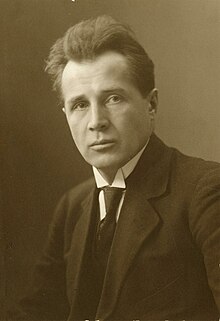| Okon Fuoko | |
|---|---|
| Ballet-pantomime by Leevi Madetoja | |
 The composer (c. 1925) | |
| Opus | 58 |
| Text | Poul Knudsen |
| Composed | 1925–1927 |
| Duration | Approx. 77 minutes |
| Movements | 1 act |
| Premiere | |
| Date | 12 February 1930 |
| Location | Helsinki, Finland |
| Conductor | Martti Similä |
| Performers | Finnish National Opera |
Okon Fuoko, Op. 58, is a ballet-pantomime for orchestra, vocal soloists, and choir by the Finnish composer Leevi Madetoja, who wrote the piece from 1925–27 concurrent with the composition of his Third Symphony. The Japonisme-influenced libretto is by Danish playwright Poul Knudsen. The story takes place in ancient Japan and, similar to Coppélia, centers around the (successful) efforts of the eponymous puppet-maker to bring a female creation to life. The result is a tragic love-triangle between the seductive doll, the infatuated Okon Fuoko, and his devastated wife. With its unique and exotic musical language, Okon Fuoko is one of Madetoja's "finest" scores; indeed, the last of his "masterpieces".
Scheduling the ballet-pantomime's premiere in Copenhagen proved difficult and the production languished unperformed until 12 February 1930, when it received its premiere in Helsinki at the Finnish National Opera under the baton of Martti Similä. Although critics praised Madetoja's music, they panned Knudsen's awkward libretto as a dramatic failure. As a result, the inaugural stage production received only three performances and thus marked the first setback of Madetoja's career, the previous major works of whom—three symphonies and an opera—the critics had received enthusiastically.
Today, the work is better known in its abridged form, a six-movement suite for orchestra that Madetoja excerpted from the stage production's score. The composer's plans for an additional two suites never materialized, although in 2009, Estonian conductor Arvo Volmer pieced together a collection of eight remaining numbers from the original score, dubbed Okon Fuoko Suite II. Volmer, conducting the Oulu Symphony Orchestra, also has produced the only recording of the complete score.